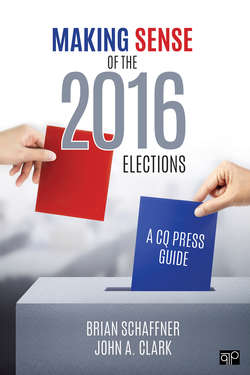Making Sense of the 2016 Elections

Реклама. ООО «ЛитРес», ИНН: 7719571260.
Оглавление
John A. Clark. Making Sense of the 2016 Elections
Making Sense of the 2016 Elections
Contents
Introduction
The Electoral Landscape in 2016
Choosing the Presidential Nominees
The Invisible Primary
The Democratic Party Decides on Clinton
The Republican Party Decides Not to Decide
The General Election Campaign
The Case for Thinking the Campaign Mattered
The Case for Thinking the Campaign Was of Minimal Importance
Campaigns Are Mostly about Mobilization
The Outcome
Another Electoral College/Popular Vote Split
Where the Election Was Won
How Key Groups Voted
Why People Voted for Trump
The Battle for Control of Congress
How Republicans Kept the Senate Red
Why Republicans Retained Their House Majority
Diversity in Congress
The 2016 Elections in the States
Governors and State Legislatures
Ballot Proposals
Putting the 2016 Election into Context
Notes
About the Authors
Отрывок из книги
A CQ Press Guide
John Moore/Getty Images
.....
While candidates jockey for position during the invisible primary, the leaders of each party generally attempt to influence the nomination process to ensure that the strongest candidate will win the nomination and represent the party in the general election campaign. This theory about the role that party elites play in the nomination processes is generally called “The Party Decides,” after the name of the influential book that describes the theory.5 Essentially, the argument is that activists, politicians, and other central players in each party tend to line up their support behind the candidate who they think would run the strongest general election campaign. In past elections, when these party leaders rallied behind a favored candidate by endorsing that candidate during the invisible primary, the favored candidate has usually prevailed in winning the nomination. For Republicans, this pattern has held in every election at least as far back as 1980. A notable exception for Democrats was 2008, when Hillary Clinton held a wide lead in endorsements over Barack Obama before the contests began but ultimately lost the nomination to him. In 2016, it was on the Republican side where the theory would once again fall short.
Hillary Clinton’s success in the Democratic primaries was in many ways a textbook example of “The Party Decides” theory, but it was not without underlying tensions. Here, for example, delegates from the party’s left wing hold up signs critical of Clinton at the Democratic National Convention in July 2016: one of several protests against the frontrunner, who was widely seen as representative of the party’s “establishment” during a heavily antiestablishment election.
.....